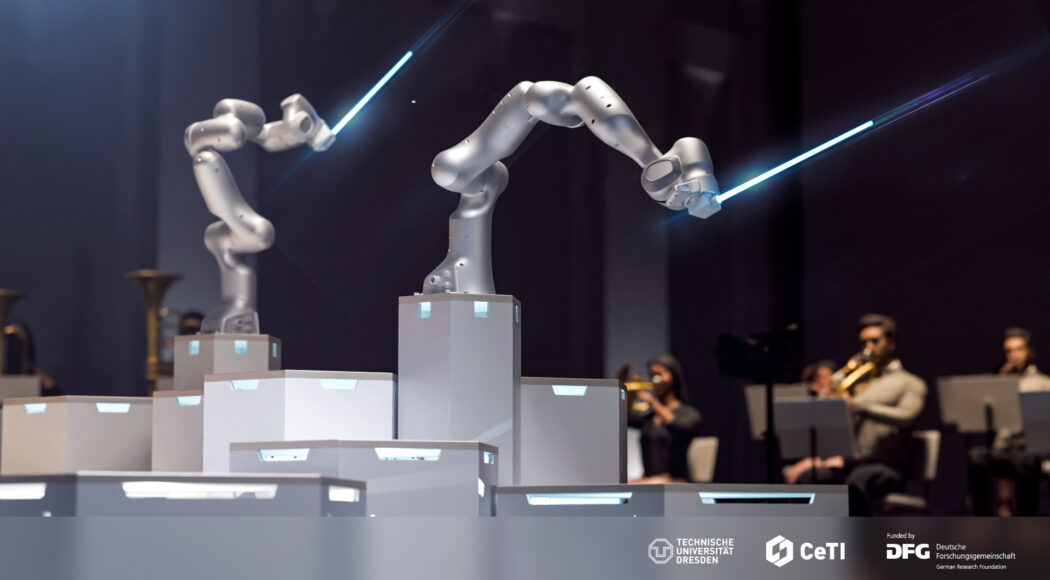ROBOTERSINFONIE
Dresdner Sinfoniker
To mark their 25th birthday and the opening of the HYBRID Biennale 2024, the Dresden Symphony Orchestra is giving itself and its audience a spectacular gift:a double concert in which robots will assist the conductor. How will the orchestra react, what impact will the new technical possibilities have on compositions and audiences of the future?
Duration: ca. 1 h 50 min
A glimpse into the future
For a quarter of a century, the Dresdner Sinfoniker have been performing innovative contemporary music at the highest artistic level. At the ROBOTERSINFONIE, their anniversary concert, an industrial robot trained by a conductor will at times take the stage. In collaboration with the CeTI Cluster of Excellence at TU Dresden, a robot is being taught how to play bars and display musical dynamics. Its movements are transferred directly to the three arms of the machine using the play-back method.
Humans, music and machines
Musicians from the Dresdner Sinfoniker will “produce” music together with a robot as a hybrid, artistic-machine product. It is precisely this moment of encounter in which a synthesis of machine precision and human creativity may emerge. How does an orchestra react when it is accustomed to translating the subtlest movements and gestures of its conductor into music? Where is the authority and charisma? Will a new musical expression possibly emerge as a result of the collaboration? And will composers break new ground in the future if they can use complex robot conducting? The ROBOTERSINFONIE project sheds light on the complex relationship between art and technology.
The ROBOTERSINFONIE program
Under the conductor Magnus Loddgard, 16 brass players and 4 percussionists from the Dresdner Sinfoniker will perform works by Markus Lehmann-Horn, Konstantia Gourzi and Wieland Reissmann in the first part of the evening. After the intermission, the conductor hands over the direction of the orchestra to his mechanical colleague, who takes on a special challenge with the world premiere of #kreuzknoten by Wieland Reissmann. Two of his three arms guide the orchestra safely through the intersecting tempi. One half of the musicians begin slowly and accelerate, while the other half slow down. Due to its rhythmic finesse, #kreuzknoten could not be conducted by a human being. This is followed by a commissioned work by composer and jazz pianist Andreas Gundlach for the Dresdner Sinfoniker. In Semiconductor’s Masterpiece, Gundlach uses the industrial robot’s ability to lead the three-piece orchestra independently through complex rhythmic passages with three arms. The journeyman’s piece by the robot conducting apprentice would certainly not exist in this form in normal life.
You can get family tickets for the performance on 13.10. for 34/44/48 €!
You can find more information about our family tickets here.
On So 13.10. there will be a live-stream of the concert by the Deutsche Welle.
Trigger warning
There will be moments of elevated noise levels during the event.
Markus Lehmann-Horn (*1977): f..A..lling. l..i..nes. (better stay human) UA
Konstantia Gourzi (*1962): Voyager II
Wieland Reissmann (*1968): Colours of Seikilos (deutsche Erstaufführung)
Intermission
Wieland Reissmann: #kreuzknoten (UA)
Kurzfilm Spot.Me (Premiere)
Andreas Gundlach (*1975): Semiconductor’s Masterpiece (UA)
Aaron J. Kernis (*1960): Musica Celestis
Conductor: Magnus Loddgard
Semiconductor: MAiRA Pro S (Industrieroboter der NEURA Robotics GmbH)
Dresdner Sinfoniker | Ostdeutsche Sparkassenstiftung together with Ostsächsischen Sparkasse Dresden | HELLERAU – European Centre for the Arts | Technische Universität Dresden | Centre for Tactile Internet with Human-in-the-Loop (CeTI) supported by Deutsche Forschungsgemeinschaft (DFG) | Wandelbots GmbH | Stiftung Kunst und Musik für Dresden
The Dresden Symphony Orchestra is supported by the City of Dresden (Office for Culture and Monument Protection) and the Saxon State Ministry for Science, Culture and Tourism.

Media Cooperation with Deutsche Welle






